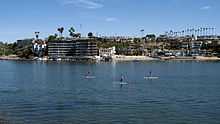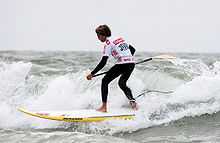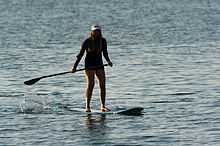Standup paddleboarding



Stand up paddle surfing and stand up paddle boarding (SUP), (Hoe he'e nalu in the Hawaiian language) are sports originating in Hawaii as an off-shoot of surfing. They enable surfers to paddle farther into the ocean than is typical or to paddle standing up as a sport unto itself. A 2013 report called it the outdoor sporting activity with the most first-time participants of any in the United States that year.[1] Paddlers race on lakes, large rivers and canals, ride breaking waves, and glide over long distances along sea coasts, often using tail winds to aid the trip.
Stand up paddlers wear a variety of wet suits and other clothing, depending on both water and air temperature since most of their time is spent standing on the board.
A related, traditional sport, paddleboarding, is done kneeling on a board and paddling with the hands, similar to a butterfly swimming stroke. The term "paddleboarding" is sometimes incorrectly used to refer to stand up paddle surfing.
Historian and writer Steve West, notes that the contemporary notion of stand up paddle boarding, if attributed to the Waikiki Beach Boys of Oahu during the 1960s, considers that outrigger canoeing should in fact be recognised as the direct link between the idea of standing on a board and propelling it with a canoe paddle, seeing as these two primary skills (board riding and paddling) were merely being combined, by people who had traditionally grown up around both skills as part of their cultural right of passage.
History
Historically, Africans and indeed many other river based and coastal cultures, have stood up within their canoes and upon rafts and paddled standing for thousands of years. Conceptually therefore, the idea of standing and paddling using an extended canoe paddle is far from being a new concept.
From a contemporary standpoint and as a sport, stand up paddle surfing really began taking off after 2005.[2]
Some historians point to this YouTube video of Duke Kahanamoku riding an Australian surf ski as one of the Genesis points of standup paddling. The video was shot in 1939 and Duke is riding a surf ski. According to Australian surf historian Nick Carroll: "What you're seeing is an Australian surf ski. This craft was invented by a bloke in Port Macquarie, New South Wales, around 1912, after he'd become intrigued by the idea of riding waves and discovered his uncle's open canoe wasn't too good at it. (In bumpy Australian sandbar waves, canoes fill with water.) The surf ski was a hollow, wood-constructed craft which was paddled with a twin blade paddle from a sitting position, but a lot of ski riders got into standing up on 'em while riding waves… Duke was given one by a touring Aussie surf team in 1939."
Laird Hamilton and Dave Kalama developed paddle surfing for the modern water sports world. The first "modern" surfer to bring Stand Up Paddle Surfing out of Hawaii and to the mainland United States was Vietnam veteran Rick Thomas.[3] Custom surf shaper Jimmy Lewis,[4] created one of the first modern production boards, the All Around. Traditional style surfers have converted to stand up paddling because of the versatility of the new sport. Stand up paddle boarding offers surfers the ability to catch more waves in a set, as well as offering a better view of incoming sets (ocean waves they may want to ride that are approaching from the sea).
Deb and Warren Thomas, owners of Standup Paddle Sports and SurfingSports.com of Santa Barbara, California, pioneered and helped establish the sport and industry of standup paddling in California. Deb Thomas was also the first female standup paddler in North America in 2005.They brought the first production SUPs to market with Maui shaper Sean Ordonez in 2006, and theirs was the first company to open a dedicated SUP store in North America, in 2007.[5]
The first magazine devoted to the sport, Standup Journal, was founded in June 2007, with its first issue published March the following year. The publication is headquartered in the state of Maine by Clay Feeter and Joyce Bilodeau.[6] The acclaimed SUP 'Bible' technical and historical publication, at over 500 pages, is written by world renowned outrigger canoeing expert and author, Steve West (Nominated for Paddle Sports Media Ambassador 2014) entitled, 'Stand Up Paddle - A Paddlers Guide' [7]
On August 8, 2007, on the North Shore of Lake Tahoe in Tahoe City, California, the first stand up paddle board race was held. 34 male and female competitors competed in a seven mile race. This was the beginning of the Ta-Hoe Nalu Paddle Festival.[8]
Kai Lenny claimed the first SUP racing world champion title when he won the seasons finals of the first Standup World Series championship races, held at Turtle Bay Resort, O'Ahu, Hawaii on September 13–14, 2012.[9]
Popularity
The Outdoor Foundation's 2013 Outdoor Participation Report, stand up paddling was listed as the most popular outdoor activity among first-time participants with 56% of all the first-time participants of outdoor activities in 2013, beating boardsailing/windsurfing which had 43% of first-time participants in 2013. The report also cited the median age for stand up paddling in 2013 as 28, accounting for 63% of all the men and 56% of all the women who participated in outdoor activities during 2013.[10]
Materials and design
New SUP board prices range from US$600 to US$1500, and most use glass-reinforced plastic construction using polyester or epoxy resin that is compatible with the polyurethane or expanded polystyrene foam used in the core. Some SUP boards use a hollow wood construction instead of foam with epoxy resin.[11] In the last few years inflatable boards have been introduced as well. The boards are generally longer than 9 feet (2,7 m), and can be longer than 12 feet (3,6 m), with features such as padded decks and concave hulls; they generally have one or three surfboard-style fins in the stern for tracking. Boards can also be a short as 7 feet, typically made out of high performance Carbon Fiber. Boards such as these are used in Stand Up Paddle Surf competitions, where a smaller board is more maneuverable.
River specific stand up paddle boards are starting to experiment with different fabrics, and polymers for the abuse the board takes in the river.[12]
Safety and Regulations
Water safety is practiced and regulated by a wide range of overlapping Federal, State, and local authorities who work to ensure the protection of life and property in coastal zones throughout the world. Depending on which country and locale in which you are surfing, local laws regulating the use of surfboards and SUP boards will vary.
US Safety Regulations
In many areas of the USA, SUP surfing is treated like body surfing, boogie boarding, or other forms of prone surfing (surfboard riding) and there are no regulations requiring the use of a personal flotation device (PFD) while using a SUP board in the surf zone. However, given the ease of moving from one area to another on a SUP board be aware that the jurisdictions[13] and rules requiring a PFD may change as you travel from the surf zone to internal waters, harbors, or other inland waterways. Additionally, some areas of the USA (such as Myrtle Beach, SC[14] or Virginia Beach, VA[15]) closely regulate beach and surf zones, requiring the use of leashes on a SUP board similar to the law for surfboards. These regulations and requirements may be enforced seasonally during high-tourism seasons or all year.
When in doubt, always check with local lifeguards, law enforcement, or civic authorities for information on how and where to practice lawful and safe SUP surfing.
UK Safety Regulations
In the UK there are no regulations for the use of a personal flotation device (PFD) while using a SUP board in the surf. In flat water environments paddlers should be aware of localised regulations requiring the use of a PFD such as on lakes, rivers and inland waterways. In a teaching environment SUP schools and clubs individual risk assessments may require the use of PFD's for less confident stand up paddle boarders but there is often no regulations enforcing this. The use of a leash is always recommended in all paddling environments and should be considered a key piece of safety equipment for Stand Up Paddle Boarding.[16] It is important to use the correct type of leashes for the water way being paddled - for instance white water paddlers/moving water paddlers should use a quick release leash and surf paddlers should use a non coiled traditional style surf leash designed specifically for the larger stand up paddle board.
Stand up paddle
A stand up paddle is a type of paddle used in stand up paddle surfing. The stand up paddle is used to propel an individual across the surface of the water while standing on a surfboard. The paddle consists of a blade, shaft and handle.
Materials and design
Paddles used for stand up surfing are similar to traditional canoe paddles only longer. They are usually constructed from carbon, fiberglass or wood with flat blade on one end connecting to a handle on the other end by a long smooth shaft. The blade ranges from 6 to 10 inches in width with an oval or round shaft ranging from 67 to 86 inches in length with a 1 to 1.5 inch diameter. Blades are designed with several shapes and features. Normally the blade has a banana peel shape sometimes having a slight keel on the back side of the blade. Other commonly used shapes include diamonds, or oar like blades. Different blade shapes are sometimes used for different types of paddling conditions (long-distance, flat lake water versus ocean surf for example).[17]
Use
The proper form for paddle surfing requires a paddle of the correct length and size. A common rule of thumb is a “shaka” length, or 5 to 7 inches, above the rider's height. While standing on board, the rider holds the paddle with one hand on the handle and the other hand approximately 1/3 of the way down the shaft. The hand placement alternates depending on what side the rider is paddling on. When paddling on the right side the handle is held with the left hand and the shaft with the right, vice versa on the left side. When paddling, the blade is placed in the water 1 to 2 feet in front of the rider. The paddle "grips" the water and is used to pull the board past the paddle. The paddle blade should angle forward, not backward, a common mistake seen with beginner paddlers.
Inflatable SUP Boards
Performance surf boards have traditionally been made from laminated layers over foam cores. SUP boards are larger boards and the desire to travel with them has led to the development of an inflatable system where the board and pump can be carried in a back pack. The core material is called 'drop stitch'. Thousands of locked nylon stitches keep the board at a specific thickness. Pressure from specially designed hand pumps can inflate a board to over 30Psi. This creates a board not much less rigid than a hard board. Two of the greatest benefits of inflatable boards are their durability and transportability.
See also
References
| Wikimedia Commons has media related to Paddle surfing. |
- ↑ "Research - Outdoor Participation - Outdoor Recreation Participation Report 2013 - Outdoor Industry Association". outdoorindustry.org. Retrieved 26 January 2015.
- ↑ "Guide To Paddleboard Yoga In OC « CBS Los Angeles." CBS Los Angeles. N.p., 13 Sept. 2013. Web. 03 Dec. 2013.
- ↑ "Stand Up Paddle Surfing Global - Interview with Rick Thomas". www.supglobal.com. Retrieved 2008-08-09.
- ↑ Jimmy Lewis http://www.outdoorindustry.org/
- ↑ Standup Journal : Summer of 2011 issue : "Who's Who of SUP" industry business guide.
- ↑ Standup Journal official site
- ↑ official site
- ↑ Ernie Brassard, Rick Thomas & Bob Pearson are the co-founders of Ta-Hoe Nalu.
- ↑ Team Naish rocks the SUP Racing World, Standup Journal
- ↑ Outdoor Industry Association's Outdoor Recreation Participation Report 2013
- ↑ "Barefoot Boards - Handcrafted Wooden Boards". www.barefoot-boards.com. Retrieved 2011-01-29.
- ↑ "GSS - Glide Paddle Boards Surface Shield".
- ↑ "Code of Federal Regulations Title 33 Part 2(A)". e-Code of Federal Regulations. U.S. Government Printing Office. Retrieved 20 December 2013.
- ↑ "Myrtle Beach Laws - MyrtleBeach.com". MyrtleBeach.com. City of Myrtle Beach. Retrieved 20 December 2013.
- ↑ "Local Ordinances of the City of Virginia Beach" (PDF). vbgov.com. City of Virginia Beach. Retrieved 20 December 2013.
- ↑ "A leash is a necessity not an accessory!". SUPboarder Mag. Retrieved 26 January 2015.
- ↑ "The ABC's of SUP boards with advice on choosing equipment".
External links
- Kanuculture /Batini Books / Steve West Publications
- History of SUP SUP Global
- Information on Stand Up Paddle worldwide
- Guide To Paddleboard Yoga In OC September 13, 2013 CBS Los Angeles
- List of SUP spots around the world
- Inflatable or Hard SUPboard SUPboarder Mag
- Stand up paddleboard glossary Gearwise
- SUP Safety and Leashes SUPboarder Mag
- A History of SUP SUPboarder Mag